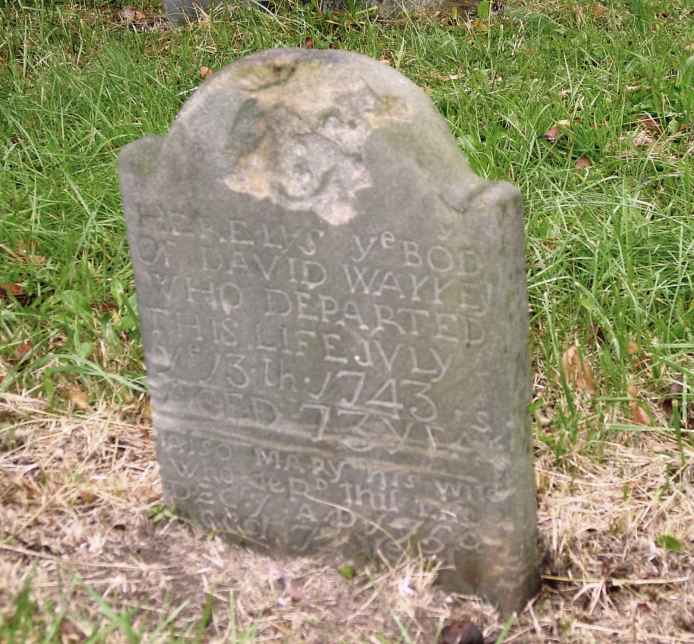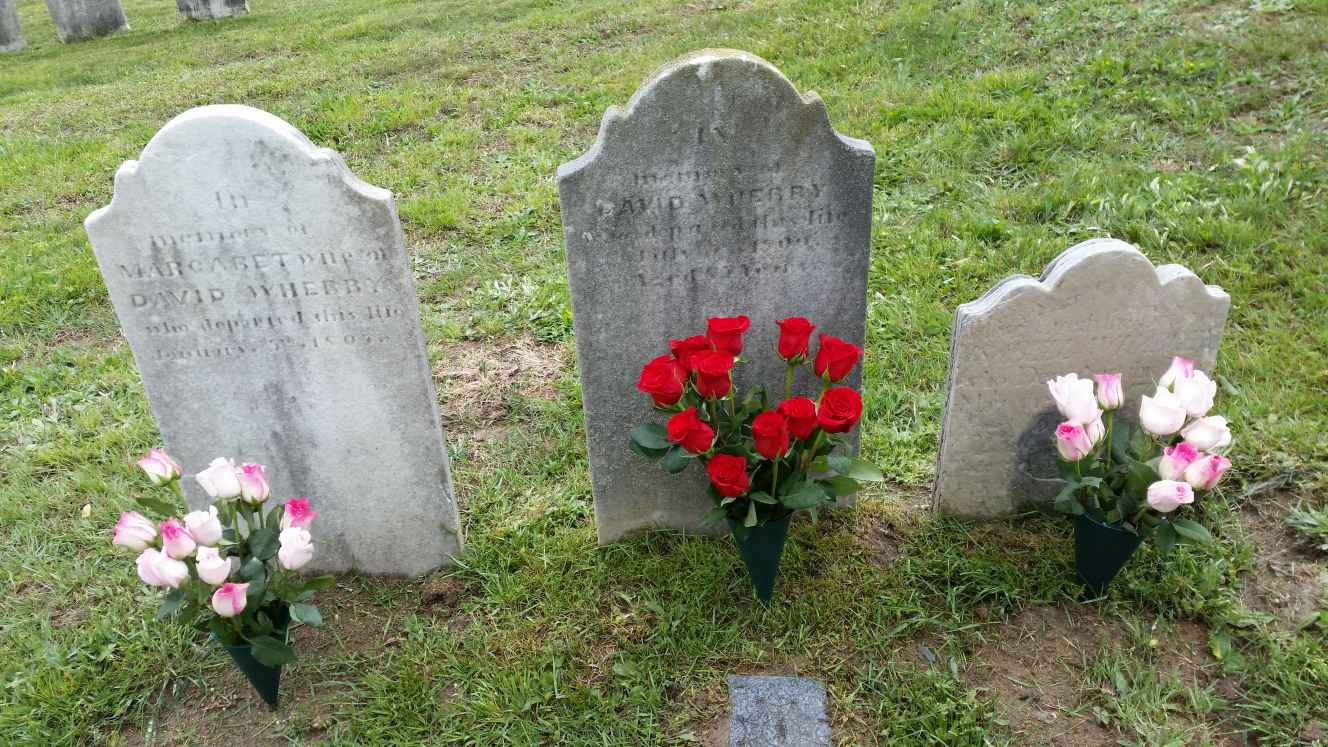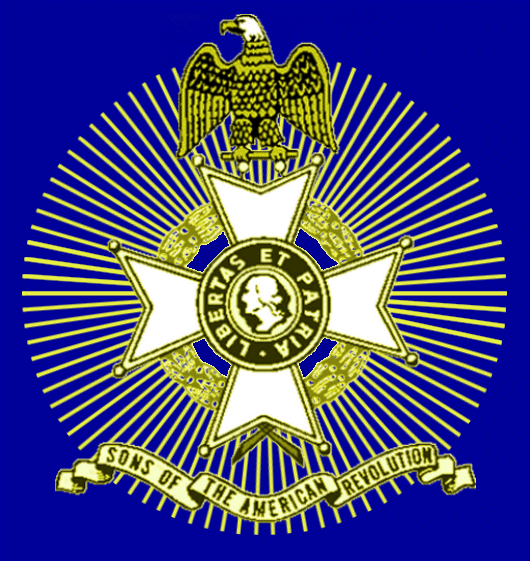The Life and Times of David Wherry Jr.
By David E. Cook, Fairfax Resolves Chapter SAR
May 7, 2016
Today we honor the life of David Wherry Jr. He was a man born in times of turmoil in Northern Ireland and here in the New World. That turmoil forged in David Wherry the man, a strong feeling of family, of religion and of patriotism. The best way to set the stage for the life and times of David Wherry, Jr. is to begin with his parents.

Wreath Laying at the grave of David Wherry
Click to Enlarge
David and his wife, Mary Leonard, along with their three children, James, David and Ann emigrated from Northern Ireland in about 1719. The precise reason for their decision to move to Pennsylvania may remain forever unknown. However, a confluence of factors that likely contributed to this decision. James Leyburn in his book, “The Scotch-Irish” assesses that some quarter of a million Ulster men immigrated to America between 1717 and the Revolutionary War. He states the reasons for this Great Migration were primarily economic but in the first years, religious considerations played a part.1
The forced settlement of Northern Ireland by the Scots in 1610 proved a great success. The English Parliament, alarmed by the competition of Irish goods, began to impose restrictive measures on the importation of goods. Similarly, absentee English property owners impressed by improvements to their Ulster properties raised rents. In addition, the six years 1714-1719 insufficient rainfall proved a calamitous for farmers. 2
Religious persecution too may have been a factor in causing the Wherry family to immigrate. The Test Act of 1704 excluded Presbyterians from civil and military offices and deprived the church’s clergy of legal standing, compounding existing difficulties regarding marriage and the law. 3 “Thus the first migration, then, was touched off by a combination of drought, rack-renting, diminished trade in woolen goods, depression and now religious vagary of emotional people; on the contrary, among the first emigrants were ministers, ready to lead their congregations to the New World”. 4
David Wherry settled with his family on property purchased from the Penn family in 17215 near what is now East Nottingham, Pennsylvania. However, his trials were not over. On 29 October 1730, David Wherry and others were accused of trespass and threats with “unlawful weapons” for clearing land near a tract of land called Mount Hope by William Ramsey, a Maryland neighbor. By virtue of a warrant sworn by William Ramsey’s Warrant Maryland, authorities entered David Wherry’s plantation and took him before a Cecil County Court. David Wherry refused to enter a plea citing that the court-lacked jurisdiction, as Mount Hope, the property in question was in Pennsylvania.
In response, Governor Gordon of Pennsylvania, in a letter dated 31 Sep 1731 to Governor Calvert of Maryland, sought redress for “found against the poor man for peaceably falling timber to fence the land that had for many years been in his possession. “ He further warned, “…that if a speedy & effectual stop is not put to such measures, I can no longer restrain our inhabitants from doing themselves justice.”6 The finding of boundary markers laid down by William Penn proved David Wherry’s case.
However, violence continued between settlers claiming various loyalties to Maryland and Pennsylvania. Conditions culminating in what some call Cresap’s War lead to the 1767 survey of the Maryland, Delaware, Pennsylvania border by Charles Mason and Jeremiah Dixon and the establishment of the Mason-Dixon Line.7

Grave marker for David Wherry Sr. at Stone Graveyard in Lewisville Chester Co., Pa.
Click to Enlarge
We believe the Wherry family became members of the Rock Presbyterian Church soon after its founding in Lewisville, Pennsylvania. The Stone Graveyard in Lewisville, the location of the first Church building, contains the graves of David Wherry Senior who died on 13 July 1743 and Mary, his wife, who died on 7 December 1759.
David Wherry, the son, became a successful farmer. He inherited half of his father’s plantation and on 4 April 1750, David Wherry added an additional forty acres adjoining his present property and along the Little Elk River in East Nottingham Township via a Pennsylvania land grant.8
David Wherry remained associated with the Rock Presbyterian Church. Church records indicate he was a church elder for many years.9
David Wherry was a good provider. He fathered 15 children by two wives, Isabella Sharpe, daughter of Thomas Sharpe, who died on 23 May 1760 and Margaret Mackey, daughter of James Mackey. Only two of his children died very young.
David Wherry, Jr. was a patriot. On December 20, 1774, David became a member of the Chester County Committee of Observation, Anthony Wayne Chairman.10 About this time, David Wherry learned of the death of his brother-in-law, John Lusk, by Indians. We do not know the precise details of his murder but family traditions suggest that the Indians cast rocks and boulders down upon him and others as they passed through a narrow pass.
On August 13, 1776, the Committee of Safety selected David Wherry as a person of suitable character to provide for the distressed families of militia members in actual service. On 1 July 1777, he took and subscribed an Oath of Allegiance and fidelity to the American Revolutionary cause before Justice Phillip Scott.11 On August 1, 1777 The Justices of the Peace for the County of Chester selected David Wherry among others, “… to take an account of all of the wheat flour grain and other stores in the county of Chester, within 20 miles distance” as the British approached Philadelphia. 12,13
At least three of David’s sons served in the military during the Revolution. Joseph (1753) Wherry was a 2nd Lt in Chester County’s East Nottingham Militia Company while, sons James (1748) and David (1753) served as privates.14 The son, David later served as an Ensign in the 8th Regiment of the Pennsylvania Continental Line. 15
David Wherry lived his life on his homestead in East Nottingham, Chester County. He died on July 7, 1800. Margaret, his wife passed away seven years later.

David Wherry Grave Marker
Click to Enlarge
David Wherry Grave Marking Program
Bibliography
1 Leyburn, James G, “The Scotch – Irish, A Social History”, 1962, Chapel Hill, NC, p 157.
2 Leyburn, p.164.
3 The Scots-Irish Journey to the New World, Dickson, Robert L, “Ulster Emigration to Colonial America, 1718-1775: Belfast (1988), p. 27.
4 Leyburn, p.168.
5 Pennsylvania Archives Vol I, Pennsylvania, 1852, p. 293.
6 Pennsylvania Archives , pp 289-293.
7 Now I know.com Cresap’s War
8 Pennsylvania, Land Warrants and Applications, 1733-1952. Harrisburg, PA: Pennsylvania State Archives
9 Jones, J. H., “A History of the Rock Presbyterian Church in Cecil County, Maryland”, 1872, Oxford, PA., p 24.
10 Pennsylvania Archives 5th Series, Vol V, “Muster Rolls and Papers Relating to the Associators and Militia of the County of Chester”, p 452.
11 Williams, Richard T. and Mildred C. “Oaths of Allegiance Chester County, Pennsylvania”, 1974, Danboreo, PA, p 34.
12 Pennsylvania Archives Vol XIV, Egle, William H. “War of the Revolution, Associated Battalions and Militia” Vol II, 1892, p 144.
13 Everts, Louis H. “History of Chester County, Pennsylvania with Genealogical and Biographical Sketches”, 1881, Philadelphia, p. 68.
14 Pennsylvania Archives 5th Series, Vol V, pp 521-522.
15 DAR RC #237493 – David Wherry

